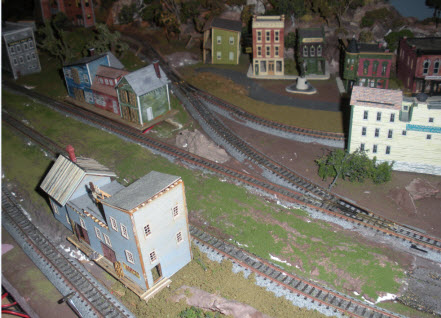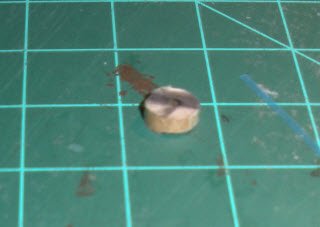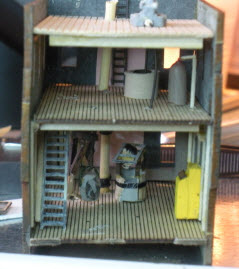Modeling Gristmill in N Scale
Takes A Good Eye and a Steady Hand
I find so many give up N Scale when they get into their sixth or seventh decade opting for the more behemoth scales to deal with diminished eyesight and shakiness without realizing both are normal and correctable.
I have stayed with N Scale despite occasions or experiencing both aspects of getting along in years. Giving up the challenge of N Scale is not something I am considering any time soon. Living the apartment life with a very understanding and considerate wife makes it possible to continue my modeling and at the same time, maintain a full blown office in a single “spare” room.
The office side uses a hollow-core door across two filing cabinets to house a desktop computer, a printer, a 22-inch HD TV and everything else I need to support an independent contractor-type business and my
Scale Modelers Handbook
website. This is where I do my writing, researching and webmaster activities. Alongside is my craftsman table where I do most of my model building.
Behind me is another hollow-core door on a large triple dresser which houses most of my clothing. The door supports a sheet of Extruded Polystyrene Foam that supports my N Scale layout.

As you can probably tell, N-Scale is the only feasible way to have a model railroad layout that has room for multiple sidings and industries along with the ability to run 10-12 car trains and sustain switching operations. The construction of buildings (kits, kitbash or scratch) is my passion as I attempt to re-create the area of the Northeast where I grew up.
That’s what gets me into working with small details and coming up with tricks that make it possible because (1) a lot of these small building components just aren’t available on the commercial market, and (2) the diminutive size makes duplication of such parts difficult when self-made.
 For instance, I am now kitbashing a quality kit of a grist mill complete with water wheel like one I remember in northern Vermont. But there were always two or three millstones lying around like spare tires. Only these were four-feet in diameter (.30 in N Scale) with a hole in the center.
For instance, I am now kitbashing a quality kit of a grist mill complete with water wheel like one I remember in northern Vermont. But there were always two or three millstones lying around like spare tires. Only these were four-feet in diameter (.30 in N Scale) with a hole in the center.
Actually, a round wooden pencil is just about the right size so I sliced one into “1-foot” pieces and found if I centered it over the jaws of my modeler’s vise spread about a quarter-inch apart, I could use a small Phillips head screwdriver and pop out the lead from the middle. If I wanted, I could belt out 25 of them from one pencil in less than 15 minutes.
Another area of kit building which has given me problems in the past is window building. Many of the laser kits come with a dozen or so three-piece, double-hung windows. I think they are a lot more realistic then their plastic brethren. But then there is getting things straight.
In N scale that means working with window panes that wouldn’t cover two letters of newsprint.

To get them straight I work with a fly-tying magnifier which allows both hands to be free. I set the window frame in a 2-piece window jig (parallel pieces of plastic separated by the width of the window frame plus tweezer tongs.
I found that by using the magnifier I can easily strip away the adhesive cover from these small parts. Being able to see the edge of the adhesive covering lets me slip the blade in between the paper and the wood.
Instead of using the supplied window pane material I opt for barely opaque plastic film which looks like a dirty window. I “paste” the window frame to the film and trim away the waste using a sharp razor blade instead of my Xacto modeling knife.
 Then pop the frame assembly into the jig to keep it straight and using the tweezers, paste on the wooden inner frame. Cap this with the lower frame, some flush with the window’s bottom, others in a “raised” position.
Then pop the frame assembly into the jig to keep it straight and using the tweezers, paste on the wooden inner frame. Cap this with the lower frame, some flush with the window’s bottom, others in a “raised” position.
Using parts and pieces from my junk box, I made mill wheels, hoppers. bins, elevators, a grain cleaner, a bolter (sifter), chutes, a crane and the main shaft to occupy all three floors.
That is just a couple of details I have built using jigs and my imagination. I am sure there will be more so stay tuned.

